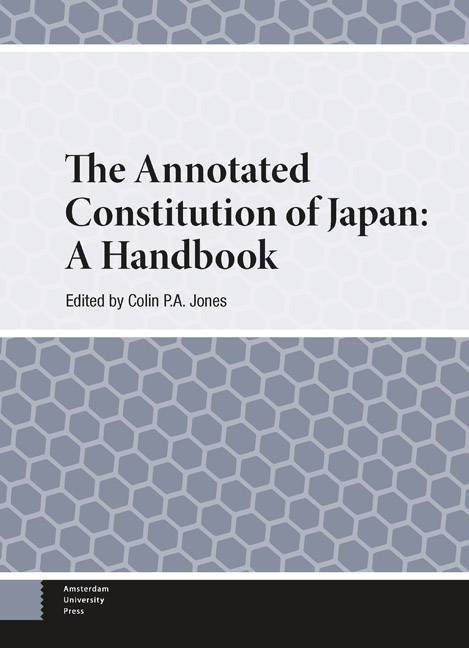Book contents
- Frontmatter
- Dedication
- Contents
- Contributors
- Preface
- Acknowledgements
- Introduction: Historical Overview
- The Preamble
- 1 Chapter I: The Emperor (Articles 1–8)
- 2 Chapter II: Renunciation of War (Article 9)
- 3 Chapter III: Rights and Duties of the People (Articles 10–40)
- 4 Chapter IV: The Diet (Articles 41–64)
- 5 Chapter V: The Cabinet (Articles 65–75)
- 6 Chapter VI: The Judiciary (Articles 76–82)
- 7 Chapter VII: Finance (Articles 83–91)
- 8 Chapter VIII: Local Self Government (Articles 92–95)
- 9 Chapter IX: Amendments (Article 96)
- 10 Chapter X: Supreme Law (Articles 97–99)
- 11 Chapter XI: Supplementary Provisions (Articles 100–103)
- Appendix 1 Constitution of the Empire of Japan (Japanese)
- Appendix 2 Constitution of the Empire of Japan (English translation)
- Appendix 3 The Potsdam Declaration
- Appendix 4 Instrument of Surrender
- Appendix 5 The “MacArthur Notes”
- Appendix 6 The GHQ Draft
- Appendix 7 The Constitution of Japan (Japanese)
- Appendix 8 The Treaty of San Francisco
- Bibliography
- Index
- Index of Articles of the Constitution of Japan
2 - Chapter II: Renunciation of War (Article 9)
Published online by Cambridge University Press: 13 February 2024
- Frontmatter
- Dedication
- Contents
- Contributors
- Preface
- Acknowledgements
- Introduction: Historical Overview
- The Preamble
- 1 Chapter I: The Emperor (Articles 1–8)
- 2 Chapter II: Renunciation of War (Article 9)
- 3 Chapter III: Rights and Duties of the People (Articles 10–40)
- 4 Chapter IV: The Diet (Articles 41–64)
- 5 Chapter V: The Cabinet (Articles 65–75)
- 6 Chapter VI: The Judiciary (Articles 76–82)
- 7 Chapter VII: Finance (Articles 83–91)
- 8 Chapter VIII: Local Self Government (Articles 92–95)
- 9 Chapter IX: Amendments (Article 96)
- 10 Chapter X: Supreme Law (Articles 97–99)
- 11 Chapter XI: Supplementary Provisions (Articles 100–103)
- Appendix 1 Constitution of the Empire of Japan (Japanese)
- Appendix 2 Constitution of the Empire of Japan (English translation)
- Appendix 3 The Potsdam Declaration
- Appendix 4 Instrument of Surrender
- Appendix 5 The “MacArthur Notes”
- Appendix 6 The GHQ Draft
- Appendix 7 The Constitution of Japan (Japanese)
- Appendix 8 The Treaty of San Francisco
- Bibliography
- Index
- Index of Articles of the Constitution of Japan
Summary
Article 9 in a global context
The single article comprising Chapter II—Article 9—is by far the most famous feature of the Constitution of Japan, and the provision that likely has the most emotional dimension for the Japanese people. Many seem to take pride in their constitution's rejection of war and the pacifistic ideals it embodies. Others may have no objections to peace, but consider the restraints as a millstone around the neck that prevents the nation from protecting itself in a dangerous world.
Within Japan and elsewhere in the world there also appears to be a widespread perception of Article 9 as a uniquely Japanese contribution to constitutionalism. In 2014, Article 9 was even nominated for a Nobel Peace Prize. The large military described as a “Self-Defense Force” and existing under a constitution that disclaims “land, sea and air forces,” could also be seen as a uniquely Japanese institution.
The reality is more complicated. The degree to which any particular aspect of Article 9 is actually unique is debatable, particularly given the Japanese government's longstanding interpretation of it as permitting the maintenance and use of military forces for self-defense. The French constitution of 1791 established its military to “to defend the State against enemies from abroad,” and postwar constitutions of nations as diverse as (for example) Germany, Italy, the Philippines, Costa Rica and South Korea contain provisions comparable to at least parts of Article 9.1 Some small countries simply do not have armed forces without addressing the subject in their constitutions. Nor do the contents of Article 9 in a constitution promulgated in 1946 make Japan an “early adopter” of some of the principles it articulates. The horrors of World War II and the numerous smaller regional conflicts that preceded it make it easy to forget that the leading nations of the world—including Japan—had already ratified an instrument formally entitled “The General Treaty for Renunciation of War as an Instrument of National Policy,” more commonly known as the Kellogg-Briand Pact of 1928.2 Japan almost immediately violated this treaty with the invasion of Manchuria in 1931, conflict with China starting from 1937, and the surprise attack on the United States and other Allied Powers in 1941.
- Type
- Chapter
- Information
- The Annotated Constitution of JapanA Handbook, pp. 32 - 46Publisher: Amsterdam University PressPrint publication year: 2023



